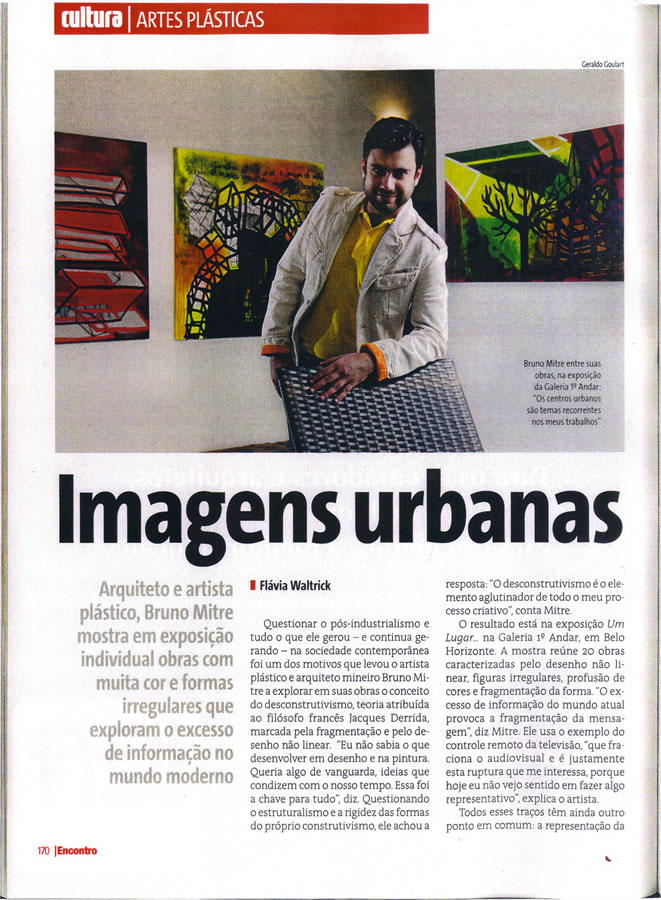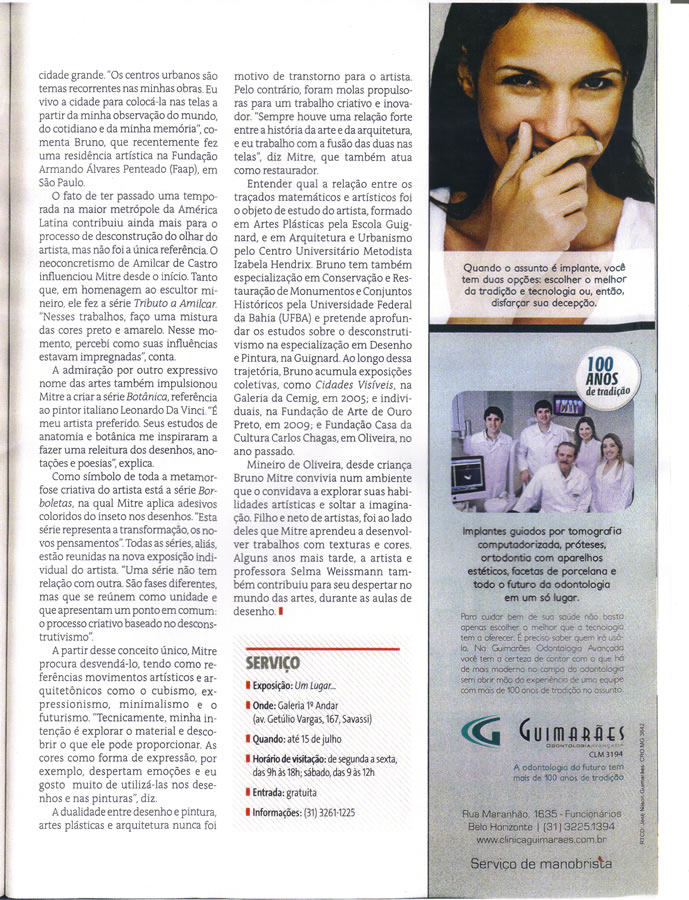

Questioning the post-industrialism and all that he has generated - and continues to generate - in contemporary society was one of the reasons why the artist and architect Bruno Mitre miner in his works to explore the concept of deconstruction, a theory attributed to the French philosopher Jacques Derrida marked by fragmentation and non-linear design. "I do not know what to develop in drawing and painting. I wanted something cutting-edge ideas that are consistent with our time. That was the key to everything, "he says. Questioning structuralism and the rigidity of its own forms of constructivism, he found the answer: "The deconstruction is the glue of all my creative process," Mitra says.
The result is the exhibition A Place ... on the 1st Floor Gallery, in Belo Horizonte. The show brings together 20 works characterized by drawing non-linear, irregular figures, the profusion of colors and fragmentation of form. "The information overload of today's world leads to fragmentation of the message," Mitre said. He uses the example of television's remote control, "which breaks the audiovisual and it is precisely this divide that interests me, because today I see no sense in doing something representative," explains the artist.
All these features have yet another thing in common: the representation of the big city."Urban centers are recurring themes in my work. I live in the city to put it on the screens from my observation of the world, everyday and my memory, "said Bruno, who recently did an artist residency at Fundação Armando Alvares Penteado (FAAP) in São Paulo.
The fact that he spent a season in the largest metropolis in Latin America, further contributed to the process of deconstruction of the artist's eye, but it was not the only reference. Neoconcretism Amilcar de Castro Mitre influenced from the beginning. So much so, in tribute to the sculptor miner, he made the series Tribute to Amilcar. "In these works, I do a mixture of black and yellow. Then I noticed how their influences were soaked, "he says.
Admiration for another significant name Mitre also boosted the arts to create the series Botany, reference to the Italian painter Leonardo Da Vinci. "It's my favorite artist. His studies of anatomy and botany inspired me to reread the drawings, notes and poetry, "he explains.
As a symbol of the whole metamorphosis of the creative artist is the series Butterflies, in which Mitre apply colored stickers on the drawings of the insect. "This series represents the transformation, new thoughts." All series, moreover, are gathered in the new solo exhibition by the artist. "A number has no relationship to another. Phases are different, but come together as a unit and that have in common: the creative process based on deconstruction. "
From this unique concept, Mitre seeks to uncover it, with the artistic and architectural references movements such as cubism, expressionism, minimalism and futurism."Technically, my intention is to explore the material and find out what it can deliver. The colors as a form of expression, for example, evoke emotions and I love to use them in drawings and paintings, "he says.
The duality between drawing and painting, arts and architecture has never been cause for disruption to the artist. Instead, they thrusts for a creative and innovative work. "There was a strong relationship between art history and architecture, and I work with the merger of the two screens," says Mitre, who also acts as a restorative.
Understand what the relationship between mathematical and artistic strokes was the object of study of the artist, graduated in Fine Arts from the School Guignard, and in Architecture and Urbanism at the Methodist University Izabela Hendrix. Bruno also has expertise in Conservation and Restoration of Monuments and Historical Collections from the Federal University of Bahia (UFBA) and intends to deepen the studies on deconstructionism in specialization in Drawing and Painting, Guignard. Along the way, Bruno accumulates exhibitions, such as Visible Cities, the Gallery of Cemig in 2005, and individual, in the Art Foundation of Ouro Preto, in 2009, and Fundação Carlos Chagas House of Culture, in Oliveira, last year .
Mineiro de Oliveira, Bruno Mitre as a child lived in an environment that invited to explore their artistic skills and unleash their imaginations. Son and grandson of artists, which was next to them Mitre learned to develop work with textures and colors. Some years later, artist and teacher Selma Weissmann also contributed to his awakening in the art world during the design workshops.
By Flavia Waltrick
Photos: Geraldo Goulart

